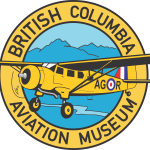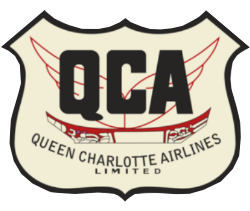
QUEEN CHARLOTTE AIRLINES (QCA) was founded in 1946 by the coastal pioneer Jim Spilsbury. The airline began when Spilsbury purchased a float plane for his Vancouver-based radio telephone company. Soon QCA (a.k.a. Queer Collection of Aircraft) was flying a regular service to logging camps and other small communities on the coast. By 1949 it was the third-largest airline in Canada. Spilsbury sold QCA to Russ Baker’s Pacific Western Airlines in 1955. The full story of the Airline can be found in Jim Spilsbury’s book ‘The Accidental Airline’.
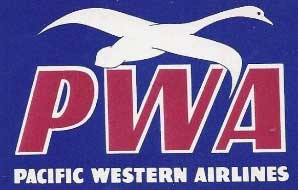
Pacific Western Airlines Ltd. (PWA) began in 1946 as Central British Columbia Airways Limited, founded by Russ Baker and Walter Gilbert, and grew by purchasing other airlines, including Kamloops Air Services (1950) and Skeena Air Transport (1951). In 1953 it became Pacific Western Airlines Ltd. In March 1987 Canadian Pacific Air was purchased by PWA Corp. CP Air had already acquired Nordair and Eastern Provincial Airways. The 4 airlines combined to form Canadian Airlines International (CAI). It later expanded with the purchase of WARDAIR.

BC Air Lines Ltd. was incorporated in 1943 by Bill Sylvester but remained inactive until 1946 because of the wartime shortage of aircraft and pilots. In 1946 it acquired 2 planes and by 1952 had increased to 18 planes, including 6 Seabees. By 1962 there were 27 aircraft and the passenger capacity was 157. The pilots had graduated from jeans and baseball caps to smart uniforms. It served 400 points of call and carried 100,000 passengers a year. In 1970 BC Air was sold to PWA. More can be read about BC Air Lines in Justin De Goutiere’s book ‘The Pathless Way’.
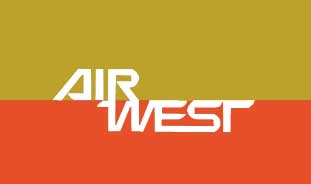
Air West was formed in 1965 as an amalgamation of Powell River Airways, formed in 1959, and Nanaimo Airlines. In 1981, Air West Airlines was one of the airlines combined to form Jim Pattison’s Air BC which later combined with Air Nova, Air Ontario and Canadian Regional Airlines to become Air Canada Regional, then Air Canada Jazz and eventually Jazz Air.

CP Air Canadian Pacific In the early 1940s, the Canadian Pacific Railway Company purchased ten bush airlines, finishing with the purchase of Canadian Airways in 1942, to form Canadian Pacific Air Lines. Early management largely consisted of bush flying pioneers. In 1968, Canadian Pacific Air Lines was rebranded as CP Air. CP Air operated from 1968 to 1986. Headquartered at Vancouver International Airport in Richmond, British Columbia, it served domestic Canadian as well as international routes until it was purchased by Pacific Western Airlines and absorbed into Canadian Airlines International. CP typically flew DC-3 aircraft into Port Hardy in the early years.
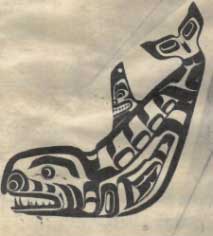
Alert Bay Air Services (ABAS) was founded in in 1958 by Don Thompson, Bill Groth and Dave Morrison with 3 planes: a 1 65 HP Piper J-3, an 85 HP Taylorcraft and a Seabee leased from Dr. Jack Pickup. In 1971, after 13 years of gradual expansion, ABAS bought Air West Air Lines’ Port Hardy operation and moved its base from Alert Bay to Port Hardy. In 1978 the airline became Gulf Air and in 1981, it was one of the airlines purchased by Jim Pattison to form Air BC.
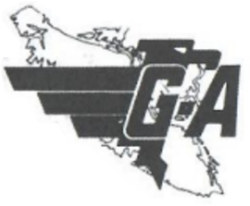
Gulf Air operated from 1978 to 1980. It was originally founded as Alert Bay Air Services and sold in 1980 to become part of Air BC.

Air BC was established in 1980 after the merger (by the Jim Pattison Group) of a number of west coast domestic airlines: Calumet Air Service, Canadian Air Transit, Flight Operation, Gulf Air Aviation, Haida Airlines, Island Airlines, Omineca Air Services, Pacific Coast Air Services and West Coast Air Services. A combined fleet emerged, including STOL capable de Havilland Canada DHC-6 Twin Otters, with some Twin Otters being operated as float planes. In 1983, STOL capable DHC-7 Dash 7 turboprop aircraft were delivered and then in 1986 DHC-8 Dash 8-100 turboprops were acquired.
In 1987, Air Canada purchased 85% of Air BC and Air BC became an Air Canada regional partner operating as an Air Canada connector.
